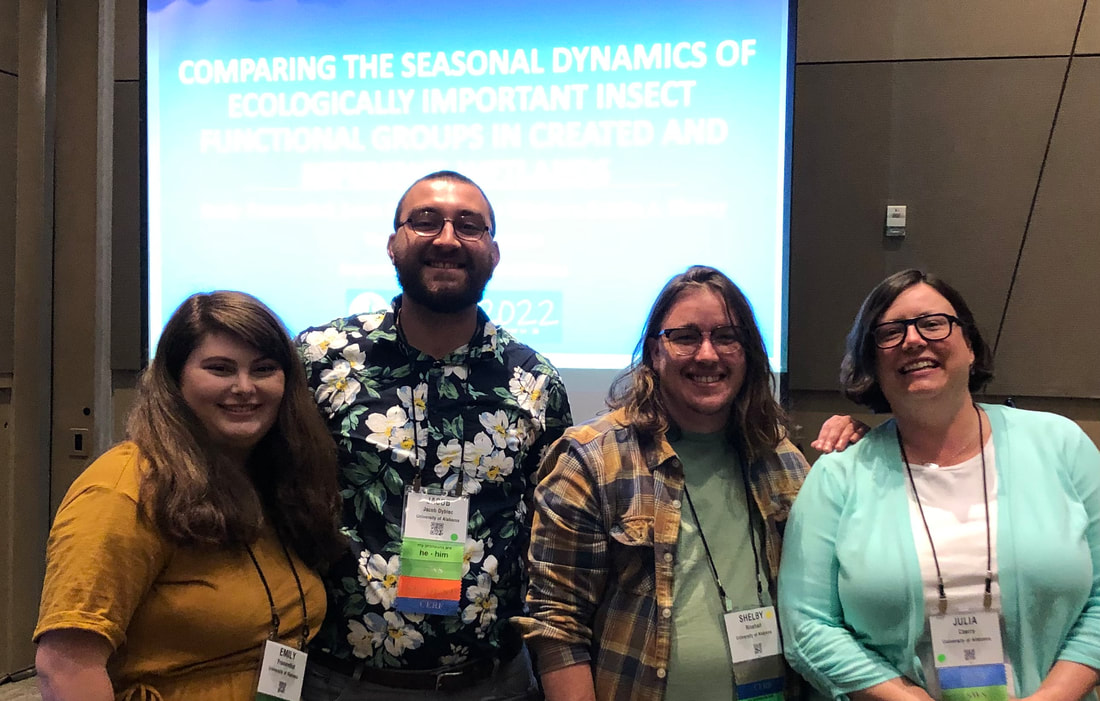Drs. Julia Cherry, Shelby Rinehart, and Behzad Mortazivi, as well as grad students Emily Fromenthal and Jacob Dybiec, presented talks in a session on coastal wetland restoration and management in the Anthropocene at the Joint Aquatic Sciences Meeting in Grand Rapids, MI. These talks provided overviews of our research on the recovery of carbon storage and nitrogen removal in restored marshes of the MS-AL Gulf Coast, using those data to develop a metric-based model of functional recovery, comparisons of insect communities in created and natural tidal marshes, and the effects of burrowing crabs on marsh sediments.
Congratulations to Jake Dybiec, a Ph.D. student in the Cherry Lab! He was recognized for giving the best oral presentation at the 2022 Mississippi Water Resources Conference, which was held in Starkville, MS on April 12-14th. Jake used data collected as part of our Sea Grant project to develop a preliminary metric-based indicator of functional recovery in restored tidal marshes of the Mississippi-Alabama Gulf Coast.
Multiple members of the Cherry lab presented their research at the CERF virtual conference this week. Dr. Cherry (on behalf of former grad student Erin Smyth) and Taylor Ledford, a graduate student in the Mortazavi lab, presented back-to-back anchor talks in the Coastal Restoration: Challenges, Successes and Innovations Session. They presented on projects examining the recovery of ecosystem functions in constructed marshes, which were conducted as part of the CRIMSON project. Dr. Shelby Rinehart, a postdoc in the Cherry lab, and graduate students, Jake Dybiec and Emily Fromenthal, also presented posters on their CRIMSON research. Their posters examined burrowing crab impacts on marsh soils, sediment flux dynamics, and shifts in insect functional groups in natural and constructed marshes along the Fowl River in Alabama.
A new paper by Simpson and others, published this week in Oecologia, details changes in mangrove cay size over time, as well as differences in forest structure and hydro-edaphic characteristics of paired cays with and without bird rookeries. Rookeries represent a potential source of nutrient inputs to mangrove systems that can serve as a proxy for increases in anthropogenic nutrient loading to coastal ecosystems. Cays with bird rookeries disappeared 13 times faster than those without birds, and these losses corresponded with lower soil organic matter, lower soil total nitrogen and carbon content, greater aboveground biomass, and greater leaf nitrogen concentration on rookery cays. Collectively, these results suggest that nutrient enrichment may reduce ecosystem stability and accelerate cay loss.
Drs. Cherry and Mortazavi both presented aspects of their collaborative research comparing ecosystem functions in natural and constructed wetlands at this week's Alabama Water Resources Conference. Mortazavi presented on the the recovery of nitrogen removal capacity in two constructed marshes along the Fowl River in Alabama, while Cherry presented on the recovery of carbon storage capacity in those same wetlands. Theses studies were carried out by a team of graduate students and postdocs in the Cherry and Mortazavi labs as part of the ongoing CRIMSON project.
Congratulations to Jake Dybiec (Ph.D. student) and Emily Fromenthal (M.S. student), both of whom received student research grants from the Society of Wetland Scientists to support their graduate research. Jake's project examines the role of sedimentation in mediating the outcomes of competition between Spartina alterniflora and Juncus roemerianus, and Emily's project compares insect communities between natural and restored marshes, with a focus on pollinators.
A second paper on research at our Fowl River marsh sites has been published in Restoration Ecology. In this study, Ledford et al. compared carbon fluxes and nitrogen removal rates between one natural and two constructed tidal marshes. Porewater ammonium, gross ecosystem productivity (GEP), ecosystem respiration, denitrification, and DNRA were similar among the three marshes, with the exception of greater denitrification in one of the two constructed sites. These results suggest that marsh restoration did recover some ecosystem functions in these 33-year-old constructed marshes.
|
Cherry Lab News & AccomplishmentsHighlighting events and recognizing achievements of current and former Cherry Lab members. Archives
May 2022
Categories
All
|













 RSS Feed
RSS Feed
